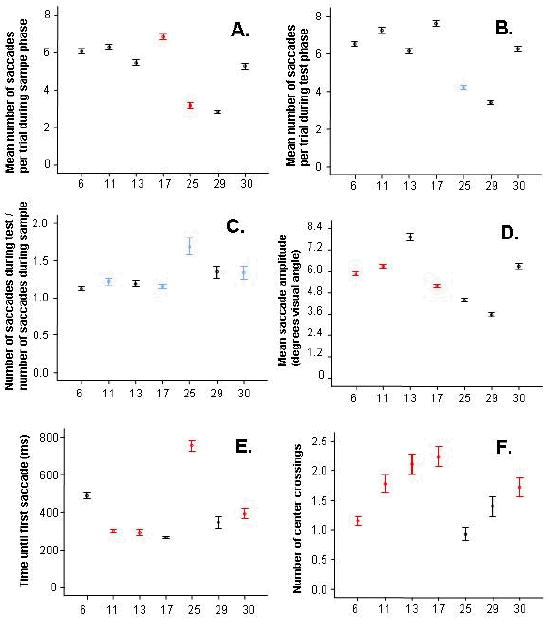Figure 5.

Eye movement variables during the test phase are plotted for each monkey according to age. Significant correlations in individual monkeys between eye-movement factors and novelty preference scores are shown in red (negative correlation) and blue (positive correlation); black points indicate no significant correlation in the individual animal. A) The two male aged monkeys showed fewer saccades during the sample phase. In both the 17-year-old CL and the 25-year-old BL, fewer saccades during this encoding phase tended to correspond to higher novelty preference scores. B) As with the sample phase, the two male aged monkeys made fewer saccades during the test phase. In contrast with the sample phase, the 25-year-old BL tended to make more saccades during trials in which he showed higher novelty preference. C) The ratio of saccades made during test versus sample phases of each trial correlated with novelty preference, suggesting a relationship between more novelty preference with longer fixations during the sample phase, and increased novelty preference with greater image exploration during the test phase. This effect was most robust in the 25-year-old monkey, BL, but was significant in four individual monkeys, and showed a strong trend in two others. D) Saccade amplitude also correlated negatively with age. E) Reaction time was not correlated with age, though there was an indication of greater variance in the aged animals (a finding examined further in Figure 6). F) While the number of center-crossings did not correlate with age, the two aged males were the only monkeys that did not show a negative correlation between center crossings and novelty preference. Error bars represent 95% confidence intervals. Generally, the aged male monkeys, BL and NS, tended to show very different patterns of eye movements, including how those movements correlated with novelty preference, than the other monkeys in the study.
